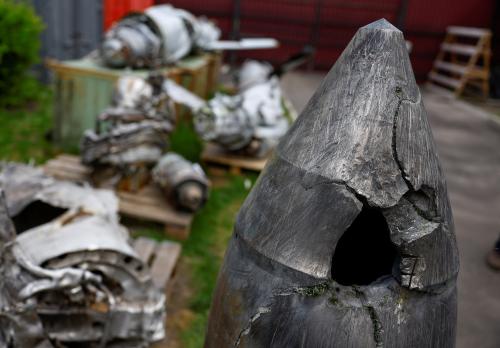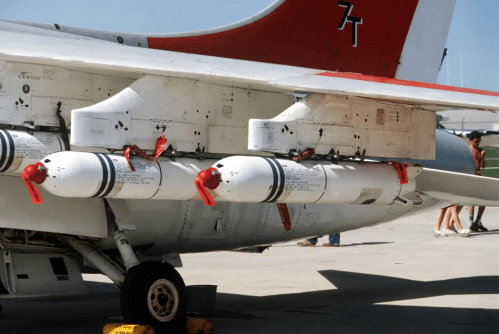In late October 2023, the Congressional Commission on the Strategic Posture of the United States, a bipartisan committee of 12 experts tasked with analyzing U.S. nuclear strategy and associated posture, released its report to Congress. The report is heavy in its focus on simultaneous threats from Russia and China and recommends “supplementing” the existing nuclear arsenal with a greater number of capabilities for more flexible response — and therefore, it assumes, deterrence — options.
As a result, for the first time since the Cold War, the national dialogue is focused on effectively increasing the size and cost of the nuclear arsenal, which exists to deter adversaries, in great contrast with the long-standing priority, history, and trajectory of reductions.
Moreover, the report reveals the presence of worst-case scenario thinking — at least by some members of the committee. It is in part driven by the possibility of a colluding Russia and China, casting the pall of a nuclear crisis onto the 2027-2035 threat landscape. Planning for this singular “doomsday” outcome is a dangerous approach.
The hazards of doomsday scenarios
My research in part focuses on how, in arms control, doomsday scenario thinking causes decisionmakers to overweigh either the likelihood or the cost of a particular outcome — more specifically, a bad one. While preparing for the worst amounts to hedging against the possibility of the most severe loss and comports with one version of responsible planning, it actually makes for poor uncertainty management — a better approach — and generates new risk.
Namely, while the report largely focuses on a singular low-probability, high-cost risk and aims to eliminate it, an uncertainty management approach accepts the fact that probabilities are estimates, acknowledges that there are “unknown unknowns” that can intercede, privileges change over stasis, and crafts a strategy to adapt to a changing security environment.
Concentrating on a specific and all-consuming threat scenario leads to a focus on capabilities (a bias) as a remedy. Consequently, it results in outcomes that impede or inhibit the ability to be nimble, flexible, and adaptable to a rapidly changing and highly uncertain security landscape. This report does just that.
Indeed, the 2023 Strategic Posture Commission report finds that the United States “lacks a comprehensive strategy to address the looming two-nuclear-peer threat environment and lacks the force structure such a strategy will require … [which must] drive necessary adjustments to the posture of U.S. nuclear capabilities — in size and/or composition.”
From a “pacing challenge” to “prepare to upload”
In contrast with the Biden administration’s National Defense Strategy, which described an acute threat from Russia and a “pacing challenge” from China, the commission’s report finds the threat from China is now (or soon will be) on par with that from Russia and notes that “the size and composition of the [U.S.] nuclear force must account for the possibility of combined aggression from Russia and China.”
As such, the report recommends that the United States “prepare to upload” (i.e., increase) its number of deployed warheads as well as increase warhead production capacity. The report also recommends increasing the production of strategic bombers, air-launched cruise missiles, ballistic missile submarines, and non-strategic nuclear forces. In addition, the report suggests that the United States prepare for the possibility of deploying multiple warheads on land-based intercontinental ballistic missiles (ICBMs) and consider the possibility of adding road-mobile ICBMs to its arsenal.
More capabilities, less strategy
In the report, the doomsday scenario outcome — combined Russian and Chinese nuclear aggression against the United States — calls for a capability-driven solution: It recommends the United States seek to deter Russia and China simultaneously with more numerous and diverse nuclear capabilities. While it also mentions the use of conventional weapons for the same purpose, it frequently notes the need to deter Russia and China with both conventional and nuclear weapons.
And perhaps revealing a lack of unanimity among the committee, it does not speak to the methods of avoiding the doomsday outcome envisioned, or the role of diplomacy in achieving that. It also does not acknowledge how conventional forces might be shored up or reconfigured to enhance nuclear deterrence. When it comes to arms control, moreover, the report recommends a role for cooperative security only “once a strategy and its related force requirements are established.”
A good strategy will be resilient in a dynamic and uncertain security environment. It should not, therefore, focus on the worst possible outcome — and certainly not on that outcome alone. Good management of potential/future risks would accept the security environment’s inherent uncertainty and employ a strategy adaptable to changing threats. It would further seek to mitigate the potential doomsday scenario outcome from occurring — not solely assume it is inevitable and call for additional capabilities to deter it.
Investments in increasing the size and diversity of the arsenal — which technically make a potential response more customizable — also make it more difficult to turn the ship around. Ramping up production of submarines and warheads, for example, takes years if not decades; it is difficult to quickly reverse course should the security landscape change.
A case for arms control
The report also dismisses how arms control contributes to the nuclear arsenal’s fundamental purpose: nuclear deterrence. The late Michael Krepon was fond of saying that arms control takes the rough edges off of deterrence. This means that, rather than deploying additional nuclear weapons, the report could lay out aspirations for negotiating agreements that shore up mutual vulnerability, perhaps by returning to the topic of limitations to missile defenses — a topic that fell out of favor entirely in the United States decades ago.
Similarly, diplomacy could be an effective tool for impeding Russian-Chinese nuclear collusion, such as by offering inducements to Beijing or by making other efforts designed to cumulatively lure China away from its strategic partnership with Russia.
Risks abound
Worse still, the report introduces new risks: the recommendations to Congress are framed in response to perceived threats from Russia and China, but also stand to kick off an arms race that would see Russia and China responding in kind —a classic security dilemma. Furthermore, the report’s recommendations will be internationally viewed as inconsistent with the U.S. obligation to “pursue negotiations in good faith on effective measures relating to cessation of the nuclear arms race at an early date and to nuclear disarmament,” as codified in Article VI of the Treaty on the Non-Proliferation of Nuclear Weapons.
On the upside, the report’s tone may incentivize states to restart arms control negotiations to gather information about the intended size and composition of one another’s arsenals — thus reducing uncertainty and increasing security. We can only hope that the report will be received by Russia and China as a signal of intent that is convincing enough to drive them to the negotiating table, and that the report’s recommendations to Congress are not yet U.S. policy.
In the meantime, the United States would do well to engage in strategies and tactics designed to avoid the worst-case scenario outcome that dominates the report, which is not a fait accompli. Rather than funding the “supplemental” programs recommended, Congress should consider how American taxpayer dollars can be applied to the project of avoiding a nuclear confrontation with Russia and China and seek out alternatives to mitigate the risk of this singular outcome coming to pass. Defaulting to capabilities-driven spending certainly is not the solution.
The Brookings Institution is committed to quality, independence, and impact.
We are supported by a diverse array of funders. In line with our values and policies, each Brookings publication represents the sole views of its author(s).








Commentary
Doomsday thinking leads the Strategic Posture Commission astray
November 13, 2023